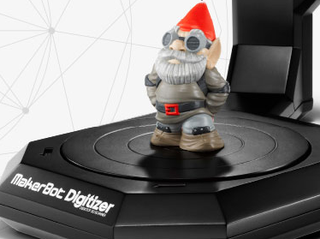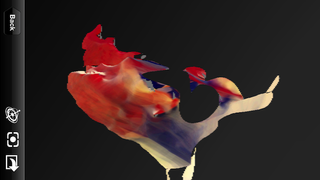Should You Buy MakerBot's $1,400 Digitizer 3D Scanner?
After an initial reveal in March, MakerBot finally reveals price for its 3D scanner, which goes on sale today. Is it worth $1,400?


Geek rockstar Bre Pettis first wowed crowds with his upcoming 3D scanning device in March at the South by Southwest Interactive Festival in Austin. But it was no more than a tease — a homemade-looking gizmo that appeared to work, but for which he provided no price.
Pettis, CEO of 3D printer manufacturer MakerBot, gave only the promise that you could place on the device any object (that would fit within a virtual cylinder 8 inches in diameter and 8 inches high) and get a digital file of good enough quality to send right to a 3D printer to make an exact copy — essentially promising a 3D Xerox machine. MakerBot calls its new machine the Digitizer.
Digitizer price may be palatable
Today (Aug. 22), the biggest question was answered: What would it cost? At $1,400, the digitizer is a pricey item, but it's possibly inexpensive enough for a curious tinkerer. After all, MakerBot's latest 3D printer, the Replicator 2, has had good sales (so says MakerBot, which hasn't yet released numbers) the steep price of $2,199 — making it one of the pricier consumer 3D printers out there. The popular Cubify Cube 3D printer, for example, sells for about $1,500. And the RepRap build-it-yourself models can be purchased as cheaply as $500.
MORE: 10 Great 3D-Printing Projects
With that in mind, $1,400 may be a palatable price point for enthusiasts, especially if they opt for a printer that's cheaper than the MakerBot Replicator. After using a laser to scan objects that rotate on a turntable, the Digitizer spits out standard 3D files that work with any 3D printer, not just MakerBot models. And the Digitizer is radically cheaper than the professional 3D scanners that cost $10,000 or more (and are not known for ease of use).
Is the MakerBot Digitizer worth it?
Still, the digitizer raises the same question that 3D printers themselves do: What's it good for? At Pettis' demo and now on the MakerBot site, the Digitizer is shown scanning a garden gnome, allowing endless plastic copies to be made. A new video on the MakerBot site shows Pettis scanning a statue of a tiger.
But are garden gnomes and tigers the most compelling applications MakerBot could think of? If so, the Replicator is essentially for taking something cheap and making even cheaper copies of it, since most consumer 3D printers are limited to plastic that, even at the highest quality settings, can still have a rough surface.
Another option, however, is to send the digital files to a 3D printing company such as Shapeways or Sculpteo; such companies can make copies in finer materials including ceramic and even silver. In that case, the plastic gnome you buy on Amazon could get an upgrade.
More likely, the Digitizer, if it works as well as advertised, would allow an artist who doesn't know or care to learn 3D design software to churn out copies of his work, such as jewelry pieces or sculpture.
Sign up to get the BEST of Tom’s Guide direct to your inbox.
Upgrade your life with a daily dose of the biggest tech news, lifestyle hacks and our curated analysis. Be the first to know about cutting-edge gadgets and the hottest deals.
MORE: How 3D Printing Is Changing Etsy
For now, at least, artists don't have to worry about people ripping off their designs with the Digitizer or other scanners. It costs more to print a silver ring, for example, than to buy one from Tiffany's.
What other 3D scanners are out there?
The Digitizer is not the only 3D scanner. But for now, at least, it may be the best. Aside from the ultrapricey and user-unfriendly pro models, there are free and supercheap apps (mostly for iOS devices), such as AutoCAD's 123D Catch, that create a 3D model from dozens of photos of an object that you take from different angles. But the results — in our tests, at least — were abysmal. Multiple attempts to capture a Spiderman PEZ dispenser resulted in only blobs reminiscent of Salvador Dalí creations.

However, the Digitizer could look rather expensive and limited when a new batch of scanners come out soon. In September, Matterform will begin accepting orders for its $599 turntable-based scanner that was crowdfunded as an Indiegogo project. Like the MakerBot Digitizer, Matterform is limited in size, able to scan only objects that would fit in a virtual cylinder that's 7.5 inches in diameter and 9.75 inches high.
On Kickstarter, a company called Fuel3D is gathering funding for a handheld scanner that can scan much larger items (including people) and capture the color of the original (which the MakerBot Digitizer can't do). It will cost $990. Fuel3D plans to start shipping its device in May 2014.
Another Kickstarter project, Volumental, will provide a 3D scanning browser plugin that uses its cloud service to process scans. A license will sell for $100, but you can download the beta software now for free. Volumental requires you to bring your own Xbox Kinect or similar depth camera (models sell for about $300 online). Like Fuel3D's device, Volumental can also scan much bigger subjects than the contents of an 8-inch cylinder in the case of the MakerBot Digitizer.
If you don't see an immediate need for a 3D scanner, limited to small objects, you may want to wait on these and other scanner projects rather than rushing out for the Digitizer. But MakerBot is known for relatively easy-to-use products and software. So if you've been craving such a device, it's probably worth a try.
Follow Sean Captain @seancaptain. Follow us @tomsguide, on Facebook and on Google+.
Sean Captain is a freelance technology and science writer, editor and photographer. At Tom's Guide, he has reviewed cameras, including most of Sony's Alpha A6000-series mirrorless cameras, as well as other photography-related content. He has also written for Fast Company, The New York Times, The Wall Street Journal, and Wired.
